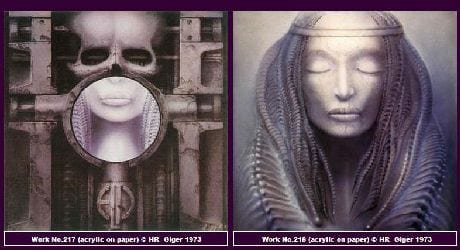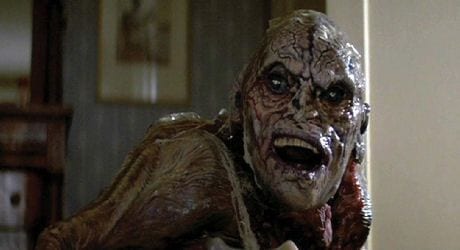He is, perhaps, the most influential surrealist of all time, arguably more important than Salvador Dali and better known than movement’s founder, Andre Breton. For some, however, the categorization doesn’t fully give Swiss artist Hans Ruedi “H.R.” Giger enough credit. To them, he was more than just a critical delineation. As a genre prophet, his impact on science fiction, fantasy, and horror is unquestioned. As an inspiration, he’s the godfather of too many cultural connections (Cyberpunk, Goth, Future Shock) to name. While some consider his work borderline pornographic (and have persecuted him for such over the years), Giger remains an embedded part of our contemporary consciousness. After all, who can look at the dual mouthed monster from Ridley Scott’s Alien and not instantly distinguish the man’s amazing style. Both instantly recognizable and frighteningly foreign, it marks the culmination, and the mere surface, of his entire creative canon.
Giger was born in 1940 in the Swiss city of Chur. His parents wanted him to pursue anything other than art. After a brief time as an architecture and industrial design student, he returned to his first passion. During the ’70s, he became a cult figure, and by the mid-’80s everyone knew his name. Today, he is a titan, with exhibitions of his works worldwide. There are even bars and clubs designed after his efforts. He was publicity shy and seldom spoke about his work in public, and since his unfortunate passing on 12 May as a result of injuries sustained in a fall, there’s been a outpouring of sympathy so strong one imagines it would embarrass the soft-spoken, white-haired man. In honor of his lifetime in the farthest reaches of our nightmares, here are 10 culturally iconic moments in Giger’s career. From album covers to motion pictures, H.R. Giger offered up a singular, inspiring vision. There’s was no one like him before. There won’t be another like him.

For many future Giger fans, this was their introduction to his mind-bending fusion of man and machinery. Keyboardist Keith Emerson is quoted as saying that the perennial prog rock act wanted an album cover that would stir things up and set their fan’s tongues wagging. The image of a beautiful if still slightly sinister female face merged with a frightening future shock container became the band’s most iconic LP image ever. Giger would go on to do more cover work, though this, and an upcoming choice, remain the most memorable from his long and legendary career.

If you weren’t a fan of extended dinosaur rock, you may have seen Giger here, in the pages one of the best and most influential genre magazines of all time. Backed by her future husband Bob Guccione (of Penthouse fame), publisher Katy Keeton longed for something “that explored all realms of science and the paranormal, that delved into all corners of the unknown and projected some of those discoveries into fiction”. Either on the cover or as illustrations for the articles within, Giger soon became an integral element to the periodicals look, feel, and sensibility.

In 1977, Giger put out a book of his diabolical, dangerous visions and the worlds of science fiction, horror, and fantasy have never been the same. The images here would go on to win him a legion of fans, a series of detractors, and an Academy Award. Indeed, as we will learn later, it was this influential tome, along with his participation in a famously never-made movie, that earned Giger the attention of Tinseltown. Thumbing through the eye-opening (and its sequel) pages here, one can see the whole of post-modern genre imagery coming into its own.

As we mentioned before, Emerson, Lake and Palmer made successful use of Giger’s visuals to sell LPs. For the famed hardcore punk band and its volatile sound, the artist allowed a poster entitled “Landscape #XX” (later dubbed “Penis Landscape”) to be included with the record. This did not sit well with a pre-PMRC populace, and before he knew it, lead singer Jello Biafra was hauled into court on obscenity charges. The incendiary front man fought the charges, but the battle almost bankrupted his tiny label Alternative Tentacles. Oddly enough, the image had been around since 1973, and was even featured in a 1977 edition of Omni.

The multi-talented writer/director/artist who Stephen King once branded “the future of horror” has made no bones about attributing the look of this horrifying Hellraiser characters to Giger and his influence. In fact, there are rumors that the long stalled remake of the original 1987 shocker was to feature creatures far more in tune with the Swiss artist’s surrealist ideals. One thing’s for sure, Barker’s basis for these “demons” offering up unsuspecting humans both the ultimate pleasure and the most horrific pain are based almost exclusively on Giger’s “flesh and fear” philosophy.
Dune and more…

After the wild success of the original film, it made perfect sense for there to be a sequel to the Steven Spielberg/Tobe Hooper fright fest. However, the production was troubled from the beginning. Not only was the older daughter (Dominique Dunne) murdered right after Poltergeist opened, but part two star Julian Beck died during the production. Giger was enlisted to help fill in those un-filmed moments when the evil Rev. Henry Kane haunted the Freeling family, though only a couple of his concepts were actually realized. What was used, however, gave this otherwise middling movie a true edge.

It was a premise right up the artist’s particularly perverse ally. The story saw some scientists splicing alien DNA with the human genome resulting in a terrifying combination of female and fiend with a singular focus to procreate. When presented with the project, Giger loved the idea, saying that he loved the challenge of looking at monsters “in another way… (as) an aesthetic warrior, also sensual and deadly, like the women look in my paintings”. While the final film displeased him (he thought it too similar to Alien), the end result was another artistic triumph for his diabolical designs.

No, not his work with Alejandro Jodorowsky. We’ll get to that in a minute. You see, when David Lynch took over the stalled sci-fi epic, Giger was actually happy. He was often quoted as saying that the auteur’s amazing Eraserhead was the closest any filmmaker had come to realize his own dark visions onscreen. Of course, few in the genre fanbase were happy with what Lynch did, but the allusions to the work done previously by those involved with Jodorowsky is embedded all over this film, especially Giger and his designs for the House Harkonnen.

We listed this as the number one unmade movie of all time, and with good reason. Alejandro Jodorowsky is one of the greatest directors in the history of cinema and his films, such as El Topo and The Holy Mountain, manifest a true visionary approach. So imagine what he could have done with the artists and actors he had gathered together for this take on Frank Herbert’s speculative sensation. Giger made one of his rare public appearances in the documentary, discussing how he became one of the director’s “spirit warriors” as well as how Lynch’s film was “influenced” by him.

Willis O’Brien will always have King Kong. Jack Pierce remains Universal’s Frankenstein’s proud papa. The Exorcist is synonymous with Dick Smith, while Rob Bottin’s work on John Carpenter’s ‘Thing’ is the stuff of legend. It’s rare when an artist can create a classic horror creature and have it last longer than a few short years, but Giger did it and did it well with his many stages of this seminal space fiend. From the eerie embryonic face hugger to chest burster and frightening phallic adult, his Alien stands proudly above and beyond all other evil ETs.


![Call for Papers: All Things Reconsidered [MUSIC] May-August 2024](https://www.popmatters.com/wp-content/uploads/2024/04/all-things-reconsidered-call-music-may-2024-720x380.jpg)



